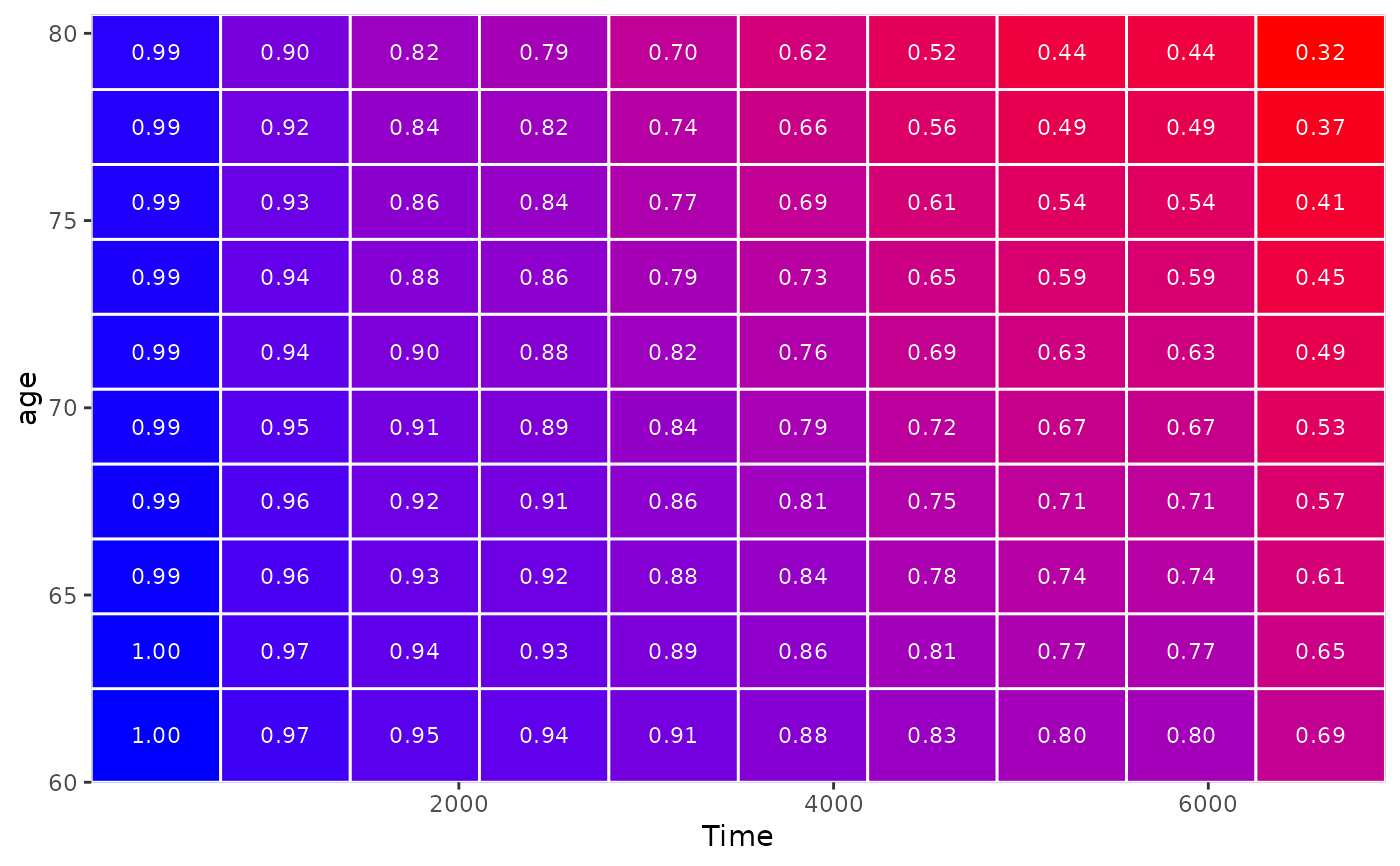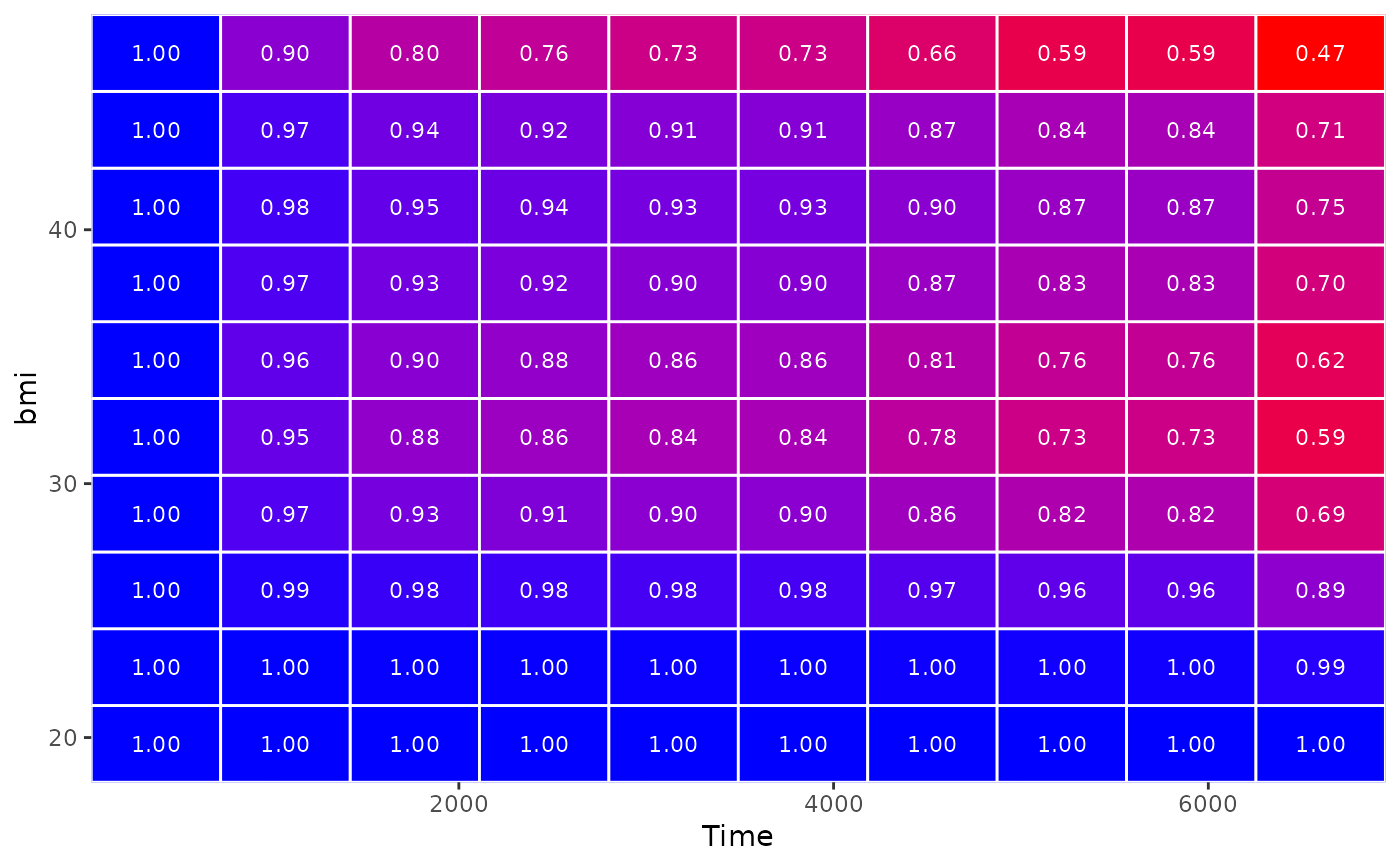
Plot a Discretized Heatmap of the Effect of a Continuous Covariate on a Time-To-Event Outcome
plot_surv_matrix.RdUsing a previously fit time-to-event model, this function plots a discretized heatmap with the continuous covariate on the y-axis and the time-to-event on the x-axis. This is essentially a discretized version of the plot_surv_heatmap plot, which makes it look very similar to a correlation matrix.
Usage
plot_surv_matrix(time, status, variable, group=NULL, data, model,
cif=FALSE, na.action=options()$na.action,
horizon=NULL, fixed_t=NULL, max_t=Inf,
n_col=10, n_row=10,
start_color="red", end_color="blue",
alpha=1, xlab="Time", ylab=variable,
title=NULL, subtitle=NULL,
legend.title="S(t)", legend.position="none",
gg_theme=ggplot2::theme_bw(),
facet_args=list(),
panel_border=FALSE, axis_dist=0,
border_color="white", border_size=0.5,
numbers=TRUE, number_color="white",
number_size=3, number_family="sans",
number_fontface="plain", number_digits=2,
...)Arguments
- time
A single character string specifying the time-to-event variable. Needs to be a valid column name of a numeric variable in
data.- status
A single character string specifying the status variable, indicating if a person has experienced an event or not. Needs to be a valid column name of a numeric or logical variable in
data.- variable
A single character string specifying the continuous variable of interest, for which the survival curves should be estimated. This variable has to be contained in the
data.framethat is supplied to thedataargument.- group
An optional single character string specifying a factor variable in
data. When used, the plot is created conditional on this factor variable, meaning that a facetted plot is produced with one facet for each level of the factor variable. Seecurve_contfor a detailed description of the estimation strategy. Set toNULL(default) to use no grouping variable.- data
A
data.framecontaining all required variables.- model
A model describing the time-to-event process (such as an
coxphmodel). Needs to includevariableas an independent variable. It also has to have an associatedpredictRiskmethod. See?predictRiskfor more details.- cif
Whether to plot the cumulative incidence (CIF) instead of the survival probability. If multiple failure types are present, the survival probability cannot be estimated in an unbiased way. This function will always return CIF estimates in that case.
- na.action
How missing values should be handled. Can be one of:
na.fail,na.omit,na.pass,na.excludeor a user-defined custom function. Also accepts strings of the function names. See?na.actionfor more details. By default it uses the na.action which is set in the global options by the respective user.- horizon
A numeric vector containing a range of values of
variablefor which the survival curves should be calculated orNULL(default). IfNULL, the horizon is constructed as a sequence from the lowest to the highest value observed invariablewith 100 equally spaced steps. In this function, this needs to be a equally spaced vector.- fixed_t
A numeric vector containing points in time at which the survival probabilities should be calculated or
NULL(default). IfNULL, the survival probability is estimated at 100 equally spaced steps from 0 to the maximum observed event time. In this function, this needs to be a equally spaced vector.- max_t
A number indicating the latest survival time which is to be plotted.
- n_col
The number of columns to use in the matrix style heatmap. This parameter only controls how many tiles are shown, not how many are estimated. The amount of estimated probabilities is controlled using the
fixed_tandhorizonarguments. See details.- n_row
The number of rows to use in the matrix style heatmap. See
n_col.- start_color
The color used for the lowest value in
horizon. This and theend_colorargument can be used to specify custom continuous color scales used in the plot. For example, if a black and white plot is desired, the user can setstart_color="white"andend_color="black". See?scale_color_gradientfor more information. Defaults to"red", set toNULLto use the default ggplot2 palette.- end_color
The color used for the highest value in
horizon. Defaults to"blue". See argumentstart_color.- alpha
The transparency level of the plot.
- xlab
A character string used as the x-axis label of the plot.
- ylab
A character string used as the y-axis label of the plot.
- title
A character string used as the title of the plot.
- subtitle
A character string used as the subtitle of the plot.
- legend.title
A character string used as the legend title of the plot.
- legend.position
Where to put the legend. See
?themefor more details.- gg_theme
A ggplot2 theme which is applied to the plot.
- facet_args
A named list of arguments that are passed to the
facet_wrapfunction call when creating a plot separated by groups. Ignored ifgroup=NULL. Any argument except thefacetsargument of thefacet_wrapfunction can be used. For example, if the user wants to allow free y-scales, this argument could be set tolist(scales="free_y").- panel_border
Whether to draw a border around the heatmap or not. Is set to FALSE by default to mimic standard heatmaps.
- axis_dist
The distance of the axis ticks to the colored heatmap. Is set to 0 by default to mimic standard heatmaps.
- border_color
The color of the individual rectangles borders. Defaults to
"white".- border_size
The size of the individual rectangles borders. Defaults to 0.5.
- numbers
Whether to put the numbers of the average estimated probabilities into the rectangles or not. Defaults to
TRUE.- number_color
The color of the numbers inside the rectangles. Ignored if
numbers=FALSE.- number_size
The size of the numbers inside the rectangles. Ignored if
numbers=FALSE.- number_family
The font family of the numbers inside the rectangles. Ignored if
numbers=FALSE.- number_fontface
The fontface of the numbers inside the rectangles. Ignored if
numbers=FALSE.- number_digits
The amount of digits the numbers inside the rectangles should be rounded to. Ignored if
numbers=FALSE.- ...
Further arguments passed to
curve_cont.
Details
Heatmaps are a great tool to visualize a three dimensional surface in a two-dimensional plot. Continuously changing colors over a single area can, however, be difficult to interpret correctly if the color does not change a lot. This version makes the heatmap easier to understand by discretizing the space into equally spaced rectangles. The survival or failure probability is still estimated at a very fine grid of points in time (controlled using the fixed_t and horizon arguments), but is then aggregated into average probabilities afterwards. The number inside each rectangle then shows the *average* probability inside the region defined by the rectangle. This makes the plot look a lot like a correlation matrix.
The dimensions of the plot can be controlled using the n_col and n_row arguments. Using high numbers in these parameters makes the plot look more similar to a standard plot_surv_heatmap plot. It is recommended to create the plot_surv_heatmap plot first to pick appropriate dimensions for the discretized version here.
References
Robin Denz, Nina Timmesfeld (2023). "Visualizing the (Causal) Effect of a Continuous Variable on a Time-To-Event Outcome". In: Epidemiology 34.5
Examples
library(contsurvplot)
library(riskRegression)
library(survival)
library(ggplot2)
library(splines)
# using data from the survival package
data(nafld, package="survival")
# take a random sample to keep example fast
set.seed(42)
nafld1 <- nafld1[sample(nrow(nafld1), 150), ]
# fit cox-model with age
model <- coxph(Surv(futime, status) ~ age, data=nafld1, x=TRUE)
# plot effect of age on survival using defaults
plot_surv_matrix(time="futime",
status="status",
variable="age",
data=nafld1,
model=model)
 # plot it only for 60 to 80 year old people
plot_surv_matrix(time="futime",
status="status",
variable="age",
data=nafld1,
model=model,
horizon=seq(60, 80, 0.5))
# plot it only for 60 to 80 year old people
plot_surv_matrix(time="futime",
status="status",
variable="age",
data=nafld1,
model=model,
horizon=seq(60, 80, 0.5))
 ## showing non-linear effects
# fit cox-model with bmi modelled using B-Splines,
# adjusting for age and sex
model2 <- coxph(Surv(futime, status) ~ age + male + bs(bmi, df=3),
data=nafld1, x=TRUE)
# plot effect of bmi on survival using defaults
plot_surv_matrix(time="futime",
status="status",
variable="bmi",
data=nafld1,
model=model2)
## showing non-linear effects
# fit cox-model with bmi modelled using B-Splines,
# adjusting for age and sex
model2 <- coxph(Surv(futime, status) ~ age + male + bs(bmi, df=3),
data=nafld1, x=TRUE)
# plot effect of bmi on survival using defaults
plot_surv_matrix(time="futime",
status="status",
variable="bmi",
data=nafld1,
model=model2)
